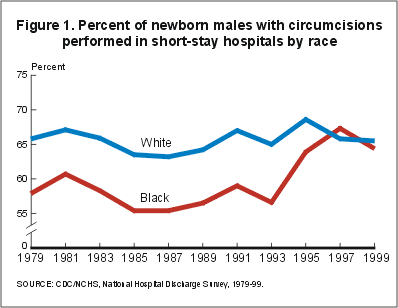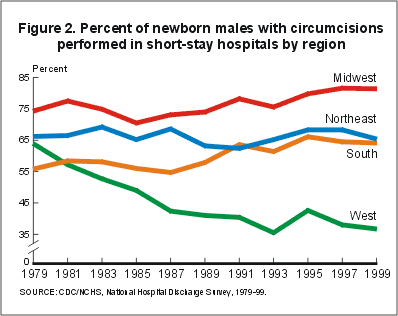Trends in circumcisions among newborns
Data from the National Hospital Discharge Survey show changes in racial and regional patterns of infant circumcisions. These findings compliment the accumulating and extensive body of knowledge pertaining to the medical benefits and risks of circumcision.
In 1999, 65.3 percent of all male newborns born in hospitals were circumcised. While the overall percentages of circumcised infants have remained relatively unchanged throughout the past two decades, ranging from a low of 60.7 percent in 1988 to 67.8 percent in 1995, different patterns emerge when these estimates are further examined by race and geographic region.
For most of the past 20 years, proportionately more white newborns received circumcisions than did black infants. Between 1980 and 1990, white infants, on average, were 13 percent more likely than black infants to be circumcised. By 1995, this percentage difference declined to about 7 percent- 68.6 percent of white infants compared to 63.9 percent of black infants. Now, circumcision rates for black and white infants are about the same. In 1999, the latest year these data are available, 65.5 percent of white newborns and 64.4 percent of black newborns were circumcised.
Newborn circumcision rates, however, have continued to vary greatly by geographic region. Over the past 20 years, proportionately more babies in the Midwest received circumcisions than did newborns in any other region- 76 percent of infants born in 1980 and 81 percent of those born during 1999. In the South, circumcisions also increased, from about 56 percent in 1980 to 64 percent in 1999. However, the most notable change occurred in the West where newborn circumcisions dropped from 62 percent in 1980 to 37 percent in 1999. This latest available figure for the West represents over a two-fold difference (2.2) when compared with circumcision estimates for the Midwest. This dramatic decline, in part, reflects the increased birth rate among Hispanics who have been shown in several other studies to be less likely to receive circumcisions than other white and black infants. In the Northeast, the circumcision rates in 1980 compared to 1999 were about the same - 67 percent and 66 percent, respectively.
Neonatal circumcision continues to be a controversial subject. The American Academy of Pediatrics has revised its earlier policy, stating that newborn circumcision has potential benefits as well as risks and emphasizing the need to explain these issues to parents considering the procedure so that an informed decision can be made.
The National Hospital Discharge Survey , a survey of patients discharged from a sample of the nation’s non-Federal short-stay hospitals, has been conducted annually by NCHS since 1965 to profile patterns and monitor change in hospital care in the United States. Additional data from the survey are presented in NCHS publications and available in public use electronic data sets.

Table 1. Percent of newborn males with circumcision performed in short-stay hospitals by race
| Year | All races | White | Black |
|---|---|---|---|
| 1979 | 64.3 | 65.8 | 57.9 |
| 1981 | 66.0 | 67.1 | 60.7 |
| 1983 | 64.6 | 65.9 | 58.3 |
| 1985 | 62.1 | 63.5 | 55.4 |
| 1987 | 61.7 | 63.2 | 55.4 |
| 1989 | 62.8 | 64.2 | 56.5 |
| 1991 | 65.6 | 67.0 | 59.0 |
| 1993 | 63.5 | 65.0 | 56.6 |
| 1995 | 67.8 | 68.6 | 63.9 |
| 1997 | 66.1 | 65.8 | 67.3 |
| 1999 | 65.3 | 65.5 | 64.4 |
SOURCE: CDC/NCHS, National Hospital Discharge Survey, 1979-99.

Table 2. Percent of newborn males with circumcision performed in short-stay hospitals by region
| Year | Northeast | Midwest | South | West |
|---|---|---|---|---|
| 1979 | 66.2 | 74.3 | 55.8 | 63.9 |
| 1981 | 66.5 | 77.5 | 58.4 | 57.2 |
| 1983 | 69.2 | 74.9 | 58.1 | 52.7 |
| 1985 | 65.2 | 70.5 | 56.0 | 49.0 |
| 1987 | 68.6 | 73.1 | 54.7 | 42.4 |
| 1989 | 63.2 | 74.0 | 57.9 | 41.0 |
| 1991 | 62.4 | 78.2 | 63.6 | 40.4 |
| 1993 | 65.2 | 75.6 | 61.4 | 35.5 |
| 1995 | 68.3 | 79.8 | 66.1 | 42.6 |
| 1997 | 68.3 | 81.6 | 64.5 | 38.0 |
| 1999 | 65.4 | 81.4 | 64.1 | 36.7 |
SOURCE: CDC/NCHS, National Hospital Discharge Survey, 1979-99.
- Page last reviewed: November 6, 2015
- Page last updated: February 3, 2010
- Content source:


 ShareCompartir
ShareCompartir